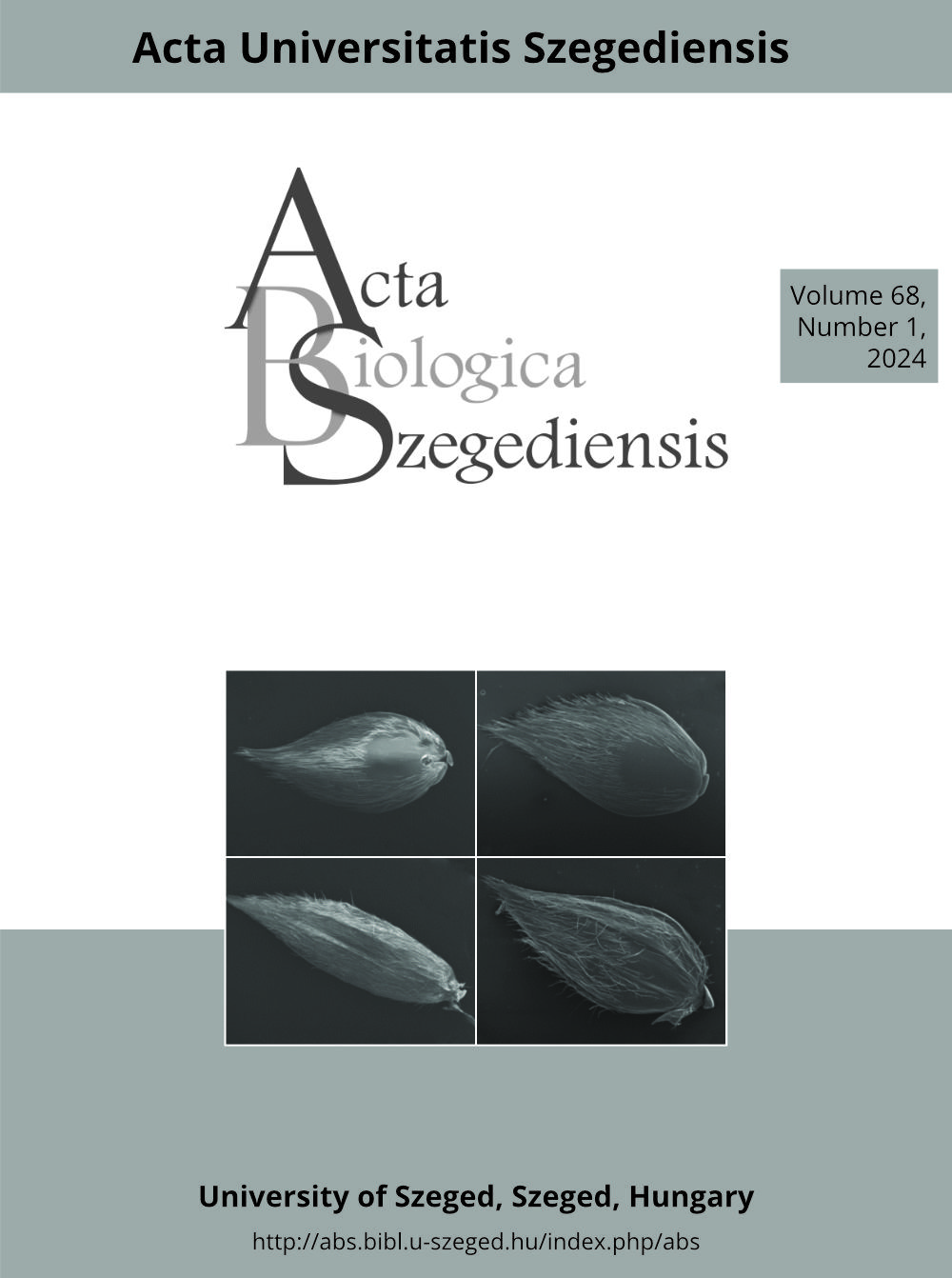GC-MS Characterization and evaluation of antioxidant potential and acute toxicity of Lupinus albus extracts
DOI:
https://doi.org/10.14232/abs.2024.1.16-22Keywords:
antioxidant activity, Lupinus albus, polyphenols, toxicityAbstract
Lupinus albus L., a leguminous plant, plays a therapeutic role due to its richness in bioactive compounds, which have diverse applications in human health, as a green fertilizer, and as fodder. This study aims to characterize Lupinus albus extracts using Gas Chromatography-Mass Spectrometry (GC-MS) and determine their total phenolic content (TPC) and total flavonoid content (TFC). The antioxidant activity (via DPPH free radical scavenging assay) and acute toxicity in Wistar rats were also evaluated. Results showed that the ethanolic extract exhibited the highest TPC (59.66 ± 0.56 mg GAE/g), while the methanolic extract had the highest TFC (14.44 ± 0.20 mg QE/g). GC-MS analysis identified 20 compounds in the ethanolic extract, with the major constituents being lupanine (54.34%), valeric acid (22.26%), and isolinoleic acid (20.94%). The ethanolic extract demonstrated significant antioxidant activity, with an IC50 of 0.86 ± 0.01 mg/mL. Acute toxicity tests indicated that the L. albus extract contributed to decreased cholesterol and stabilized glycemia at a dose of 2000 mg/kg body weight.
Downloads
References
Abarca-Vargas R, Zamilpa A, Petricevich VL (2019) Development and validation of conditions for extracting flavonoids content and evaluation of antioxidant and cytoprotective activities from Bougainvillea x buttiana bracteas (var. Rose). Antioxidants 8:1-16.
Al Juhaimi F, Şimşek Ş, Ghafoor K, Babiker E, Özcan MM, Ahmed IAM, Alsawmahi O (2019) Effect of varieties on bioactive properties and mineral contents of some Sorghum, Millet and Lupin seeds. J Oleo Sci 68(11):1063-1071.
Alagawany M, Elnesr SS, Farag MR, Abd El-Hack ME, Khafaga AF, Taha AE, Tiwari R, Yatoo MI, Bhatt P, Khurana SK (2019) Omega-3 and omega-6 fatty acids in poultry nutrition: Effect on production performance and health. Animals 9:573.
Amany AT, Mohga SA, Adel KI, Khaled FM, Rasha SM (2013) The effect of Lupinus albus (Termis) and Hyphaene thebaica (Doum) on some biochemical parameters in streptozotocin-induced diabetic rats. Egypt J Hosp Med 53:789-794.
Ben Hassine A, Rocchetti G, Zhang L, Senizza B, Zengin G, Mahomoodally MF, Ben-Attia M, Rouphael Y, Lucini L, El-Bok S (2021) Untargeted phytochemical profile, antioxidant capacity and enzyme inhibitory activity of cultivated and wild Lupin seeds from Tunisia. Molecules 26:3452.
Ben Younes A, Ben Salem M, El Abed H, Jarraya R (2018) Phytochemical screening and antidiabetic, antihyper-lipidemic, and antioxidant properties of Anthyllis henoniana (Coss.) flowers extracts in an alloxan-induced rats’ model of diabetes. J Evid-Based Complement Altern Med 2018:1-14 .
Blainski A, Lopes GC., Palazzo de Mello JC (2013) Application and analysis of the Folin Ciocalteu method for the determination of the total phenolic content from Limonium brasiliense L. Molecules 18:6852-6865.
Braca A, Sortino C, Politi M, Morelli I, Mendez J (2002) Antioxidant activity of flavonoids from Licanialicaniae flora. Ethnopharmacol 79(3):379-381.
Buszewski B, Rafńska K, Cvetanović A, Walczak J, Krakowska A, Rudnicka J, Zeković Z (2019) Phytochemical analysis and biological activity of Lupinus luteus seeds extracts obtained by supercritical fluid extraction. Phytochem Lett 30:338-348.
Dalaram IS (2016) Evaluation of total polyphenol content and antioxidant capacity of different verity lupin seeds. Potr Slov J Food Sci11(1) : 2 6 -3 4 .
Dehpour A, Ibrahimzadeh MA, Seyedfazelet N, Seyed M (2009) Antioxidant activity of the methanol extract of Ferula assa foetida and its essential oil composition. Grasas Y Aceites 60(4):405-412.
Dontha SA (2016) Review on antioxidant methods. Asian J Pharm Clin Res 9:14-32.
El-Awadi ME, Shalaby MAF, Ahmed HFS, Abd El-Hamid EM, Abd El-Azem FS, Moustafa SMA (2018) Phytochemical constituents of methanol and aqueous extracts of Lupinus termis L. seeds using GC-MS. Middle East J Appl Sci 1:272-286.
Elsawi SA, Aly HF, Elbatanony MM, Maamoun AA, Mowawad DM (2018) Phytochemical evaluation of Lagerstroemia indica (L.) Pers. leaves as anti-Alzheimer’s. J Mater Environ Sci 9(9):2575-2586.
Fontanari GG, Batistuti JP, Cruz RJ, Hilário Saldiva PN, Arêas José AG(2012) Cholesterol-lowering effect of whole lupin (Lupinus albus) seed and its protein isolate. Food Chem 132:1521-1526.
Gang-Jee K, Connie M, Kamyar KZ, Shivam J (2020) The effects of high-protein diets on kidney health and lon-gevity. J Am Soc Nephrol 31:1667-1679.
Gharib M, Samani LN, Panah ZE, Naseri M, Bahrani N, Kiani K (2015) The effect of valeric on anxiety severity in women undergoing hysterosalpingography. Glob J Health Sci 7(3):358-363.
Ghezelbash GR, Parishani MR, Fouani MH (2015) Antimicrobial activity of Salvia officinalis acetone extract against pathogenic isolates. Herb Drugs 5(4):215-218.
Gresta F, Oteri M, Scordia D, Costale A, Armone R, Meineri G, Chiofalo B (2023) White lupin (Lupinus albus L.), an alternative legume for animal feeding in the Mediterranean area. Agriculture 13:434.
Hanania M, Radwan S, Abu OS., Qumber A (2019) Determination of minerals, total phenolic content, flavonoids, antioxidants and antimicrobial activities of ethanolic extract of sweet Lupinus angustifolius of Palestine. Eur J Med Plants28(1):1-6.
Hanania M, Radwan S, Karmi E (2018) Extraction method and evaluation of phenolics, flavonoids, antioxidant activity, antimicrobial activity and minerals of bitter Lupinus albus in Palestine. J Biol Active Prod Nature 8 (2):137-143.
Hartman RE, Ross DM (2018) Effects and mechanisms of actions of phytochemicals on Alzheimer’s disease neuropathology. Front Biosci (Elite Ed) 10(2):300-333.
Karamać M, Orak HH, Amarowicz R, Orak A, Piekoszewski W (2018) Phenolic contents and antioxidant capacities of wild and cultivated white lupin (Lupinus albus L.) seeds. Food Chem258:17.
Lampart-Szczapa E, Siger A, Trojanowska K, Nogala-Kalucka M, Malecka M, Pacholek B (2003) Chemical composition and antibacterial activities of lupin seeds extracts. Nahrung/Food 47(5):286-290.
Martins JM, Riottot M, de Abreu MC, Viegas-Crespo AM, Lança MJ, Almeida JA, Freire JB, Bento OP (2005) Cholesterol-lowering effects of dietary blue lupin (Lupinus angustifolius L.) in intact and ileorectal anastomosed pigs. J Lipid Res 46:1539-1547.
Mazumder K, Nabila A, Aktar A, Farahnaky A (2020) Bioactive variability and in vitro and in vivo antioxidant activity of unprocessed and processed flour of nine cultivars of Australian lupin species: A comprehensive substantiation. Antioxidants 9(4):282.
Mirmiran P, Gaeini Z, Bahadoran Z, Azizi F (2019) Elevated serum levels of aminotransferases in relation to unhealthy foods intake: Tehran lipid and glucose study. BMC Endocr Disord 19:100.
Panasiewicz K (2022) Composition of lupin (Lupinus spp.) as influenced by variety and tillage system. Agriculture 12:263.
Paramastri R, Hsu CY, Chuang YK, Lee HA, Wiratama BS, Chao Jane C-J (2021) Synergistic interaction of dietary pattern and concordance lifestyle with abnormal liver function among young adults in Taiwan: A population-based longitudinal study. Nutrients 13:3591.
Prusinski J (2017) White lupin (Lupinus albus L.) - Nutritional and Health Values in Human Nutrition – a review. Czech J Food Sci35 (2):95 -105.
Rahman MM, Ahmad SH, Mohamed MTM, Ab Rahman MZ (2014) Antimicrobial compounds from leaf extracts of Jatropha curcas, Psidium guajava, and Andrographispaniculata. Sci World J 2014:635240.
Raju MG, Sundar Reddy TH (2017) Aristolochia bracteolata– antihyperglycemic and antihyperlipidemic activity in dexamethasone-induced diabetic rat model. Asian J Pharm Clin Res 10(8):75-77.
Safdar MN, Kausar T, Jabbar S, Mumtaz A, Ahad K, Saddozai AA (2016) Extraction and quantification of polyphenols from kinnow (Citrus reticulate L.) peel using ultrasound and maceration techniques. J Food Drug Anal 25(3):485-500.
Siger A (2012) Antioxidant activity and phenolic content in three lupin species. Subtrop Plant Sci 25:190-197.
Sirtori CR, Lovati MR, Manzoni C, Castiglioni S, Duranti M, Magni C, Morandi S, D’Agostina A, Arnoldi A (2004) Proteins of white lupin seed, a naturally isoflavone-poor legume, reduce cholesterolemia in rats and increase LDL receptor activity in HepG2 cells. J Nutr 134(1):18-23.
Staels B, Fonseca VA (2009) Bile acids and metabolic regulationmechanisms and clinical responses to bile acid seques-tration. Diabetes Care 32(2):237-245.
Tosun M, Ercisli S, Sengul M, Ozer H, Polat T, Ozturk E (2009) Antioxidant properties and total phenolic content of eight Salvia species from Turkey. Biol Res 42(2):175-181.
Vishwakarma S, Goyal R, Gupta V, Dhar KL (2016) GAB-Aergic effect of valeric acid from Valeriana wallichii in amelioration of ICV STZ induced dementia in rats. Rev Bras Farmacogn 26:484-489.
Wiedemann M, Gurrola-Diaz CM, Vargas-Guerrero B, Wink M, Garcia-Lopez PM, Dufer M (2015) Lupanine improves glucose homeostasis by influencing KATP channels and insulin gene expression. Molecules 20:19085-19100.
Zhou K, Yu L (2004) Effects of extraction solvent on wheat bran antioxidant activity estimation. LWT - Food Sci Technol 37(7):717-721








